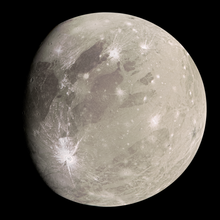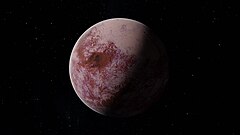| Revision as of 21:00, 26 July 2023 editRuslik0 (talk | contribs)Edit filter managers, Administrators54,831 edits sp← Previous edit | Latest revision as of 18:23, 1 December 2024 edit undoThePurgatori (talk | contribs)Extended confirmed users801 editsNo edit summaryTags: Mobile edit Mobile web edit Advanced mobile edit | ||
| (23 intermediate revisions by 8 users not shown) | |||
| Line 2: | Line 2: | ||
| {{about|the type of planet smaller than giant planets|the film|Ice Planet (film)|the type of giant planet|ice giant}} | {{about|the type of planet smaller than giant planets|the film|Ice Planet (film)|the type of giant planet|ice giant}} | ||
| {{more citations needed|date=May 2014}}], the largest known solid icy body in the Solar System]] | {{more citations needed|date=May 2014}}], the largest known solid icy body in the Solar System]] | ||
| ⚫ | An '''ice planet''' or '''icy planet''' is a type of ] with an icy surface of ] such as ], ], and ]. Ice planets consist of a global ].<!--URANUS AND NEPTUNE ARE ICE *GIANT PLANETS*; THEY DON'T HAVE ANY *ICY SURFACE*--> | ||
| ] | |||
| ⚫ | An '''ice planet''' or '''icy planet''' is a type of ] with an icy surface of ] such as ], ], and ]. Ice planets consist of a global ]. | ||
| Under a ], the small icy worlds of the ] qualify as icy planets. These include most of the ]s, such as ], ], ], and ]; |
Under a ], the small icy worlds of the ] qualify as icy planets. These include most of the ]s, such as ], ], ], ], and ]; ]s ], ], ], ], ], ], ], and ]; and the largest ]s. In June 2020, ] reported that it is likely that ]s with oceans, including some with oceans that may lie beneath a layer of surface ice, may be common in the ], based on ].<ref name="EA-20200618">{{cite news |author=NASA |author-link=NASA |title=Are planets with oceans common in the galaxy? It's likely, NASA scientists find |url=https://www.eurekalert.org/pub_releases/2020-06/nsfc-apw061820.php |date=18 June 2020 |work=] |access-date=20 June 2020 }}</ref><ref name="NASA-20200618">{{cite news |author=Shekhtman, Lonnie |display-authors=et al. |title=Are Planets with Oceans Common in the Galaxy? It's Likely, NASA Scientists Find |url=https://www.nasa.gov/feature/goddard/2020/are-planets-with-oceans-common-in-the-galaxy-it-s-likely-nasa-scientists-find |date=18 June 2020 |work=] |access-date=20 June 2020 }}</ref> ], first observed in 2005, is a possible ice planet. | ||
| == Characteristics and habitability == | == Characteristics and habitability == | ||
| ] | ] | ||
| ] | ] | ||
| An ice planet's surface can be composed of ], ], ], ] (known as "]"), ], ], and other volatiles, depending on its surface temperature. Ice planets would have surface temperatures below 260 ] (−13 °C) if composed primarily of ], below 180 K (−93 °C) if primarily composed of CO{{sub|2}} and ], and below 80 K (−193 °C) if composed primarily of methane. | An ice planet's surface can be composed of ], ], ], ] (known as "]"), ], ], and other volatiles, depending on its surface temperature. Ice planets would have surface temperatures below 260 ] (−13 °C) if composed primarily of ], below 180 K (−93 °C) if primarily composed of CO{{sub|2}} and ], and below 80 K (−193 °C) if composed primarily of methane. | ||
| On the surface, ice planets are hostile to life forms like those living on Earth because they are extremely cold. Many ice worlds likely have ]s, warmed by ] or ]s from another nearby body. Liquid subsurface water would provide habitable conditions for ], including ], ], and ]s. Subsurface plants as we know them could not exist because there is no sunlight to use for ]. Microorganisms can produce nutrients using specific chemicals (]) that may provide food and energy for other organisms. Some planets, if conditions are right, may have significant atmospheres and surface liquids like Saturn's moon ], which could be habitable for ]. | On the surface, ice planets are hostile to life forms like those living on Earth because they are extremely cold. Many ice worlds likely have ]s, warmed by ] or ]s from another nearby body. Liquid subsurface water would provide habitable conditions for ], including ], ], and ]s. Subsurface plants as we know them could not exist because there is no sunlight to use for ]. Microorganisms can produce nutrients using specific chemicals (]) that may provide food and energy for other organisms. Some planets, if conditions are right, may have significant atmospheres and surface liquids like Saturn's moon ], which could be habitable for ]. | ||
| == |
== Examples == | ||
| === In solar system === | |||
| Although there are many icy objects in the ], none of them qualify as planets under the ]. However, most ]s are ice-rock (e.g. ], ], ], ], and ]) or even primarily ice (e.g. ], ], and ]) and so qualify as ice planets under ] of the term. The largest ] objects, such as ] |
Although there are many icy objects in the ], none of them qualify as planets under the ]. However, most ]s are ice-rock (e.g. ], ], ], ], and ]) or even primarily ice (e.g. ], ], ], ], and ]) and so qualify as ice planets under ] of the term. The largest ] objects, such as ], ], ], ], ], and ]<ref name="Wiley-2005">{{cite web |last1=Stern |first1=Alan |last2=Mitton |first2=Jacqueline |author-link2=Jacqueline Mitton |title=Pluto and Charon: ice worlds on the ragged edge of the solar system |url=http://www.worldcat.org/search?q=isbn%3A3527405569 |date=2005 |publisher=Weinheim: ] |access-date=July 13, 2013 }}</ref> also qualify as such under geophysical definitions. ] is also often considered an ice planet due to its surface ice, though its high density indicates that its interior is mostly rocky. The same is true for the scattered-disc objects {{dp|Sedna}}, {{dp|Gonggong}} and {{dp|Eris}}.<ref name=planetarysociety>Emily Lakdawalla et al., The Planetary Society, 21 April 2020</ref> | ||
| === Beyond solar system === | |||
| There are several extrasolar ice planet candidates, including ], OGLE-2013-BLG-0341LB b and ]. | |||
| Dozens of known exoplanets are very probably ice planets, given their orbits, surfaces, densities, and host stars. Examples of ice planets include ], ], ], ], ], ] and ].{{cn|date=November 2024}} | |||
| == See also == | == See also == | ||
| * ] | * ] | ||
| * ] | * ] | ||
| * ] | |||
| * ] | * ] | ||
| * ] | * ] | ||
| * |
* {{Annotated link|Hoth}} | ||
| == References == | == References == | ||
| Line 37: | Line 36: | ||
| ] | ] | ||
| ] | ] | ||
| ] | |||
Latest revision as of 18:23, 1 December 2024
Planet with an icy surface This article is about the type of planet smaller than giant planets. For the film, see Ice Planet (film). For the type of giant planet, see ice giant.| This article needs additional citations for verification. Please help improve this article by adding citations to reliable sources. Unsourced material may be challenged and removed. Find sources: "Ice planet" – news · newspapers · books · scholar · JSTOR (May 2014) (Learn how and when to remove this message) |

An ice planet or icy planet is a type of planet with an icy surface of volatiles such as water, ammonia, and methane. Ice planets consist of a global cryosphere.
Under a geophysical definition of planet, the small icy worlds of the Solar System qualify as icy planets. These include most of the planetary-mass moons, such as Ganymede, Titan, Europa, Enceladus, and Triton; dwarf planets Pluto, Orcus, Haumea, Makemake, Quaoar, Sedna, Gonggong, and Eris; and the largest comets. In June 2020, NASA scientists reported that it is likely that exoplanets with oceans, including some with oceans that may lie beneath a layer of surface ice, may be common in the Milky Way galaxy, based on mathematical modeling studies. OGLE-2005-BLG-390Lb, first observed in 2005, is a possible ice planet.
Characteristics and habitability


An ice planet's surface can be composed of water, methane, ammonia, carbon dioxide (known as "dry ice"), carbon monoxide, nitrogen, and other volatiles, depending on its surface temperature. Ice planets would have surface temperatures below 260 K (−13 °C) if composed primarily of water, below 180 K (−93 °C) if primarily composed of CO2 and ammonia, and below 80 K (−193 °C) if composed primarily of methane.
On the surface, ice planets are hostile to life forms like those living on Earth because they are extremely cold. Many ice worlds likely have subsurface oceans, warmed by internal heat or tidal forces from another nearby body. Liquid subsurface water would provide habitable conditions for life, including fish, plankton, and microorganisms. Subsurface plants as we know them could not exist because there is no sunlight to use for photosynthesis. Microorganisms can produce nutrients using specific chemicals (chemosynthesis) that may provide food and energy for other organisms. Some planets, if conditions are right, may have significant atmospheres and surface liquids like Saturn's moon Titan, which could be habitable for exotic forms of life.
Examples
In solar system
Although there are many icy objects in the Solar System, none of them qualify as planets under the IAU definition of planet. However, most planetary-mass moons are ice-rock (e.g. Ganymede, Callisto, Enceladus, Titan, and Triton) or even primarily ice (e.g. Mimas, Tethys, Dione, Rhea, and Iapetus) and so qualify as ice planets under geophysical definitions of the term. The largest Kuiper belt objects, such as Pluto, Haumea, Makemake, Charon, Quaoar, and Orcus also qualify as such under geophysical definitions. Europa is also often considered an ice planet due to its surface ice, though its high density indicates that its interior is mostly rocky. The same is true for the scattered-disc objects Sedna, Gonggong and Eris.
Beyond solar system
Dozens of known exoplanets are very probably ice planets, given their orbits, surfaces, densities, and host stars. Examples of ice planets include Gliese 667 C d, Gliese 667 C g, Kepler-441b, OGLE-2005-BLG-390Lb, OGLE-2013-BLG-0341LBb, OGLE-2016-BLG-1195Lb and MOA-2007-BLG-192Lb.
See also
- Ice giant
- Icy moon
- Ocean world
- Snowball Earth
- Hoth – Fictional planet in Star Wars
References
- NASA (18 June 2020). "Are planets with oceans common in the galaxy? It's likely, NASA scientists find". EurekAlert!. Retrieved 20 June 2020.
- Shekhtman, Lonnie; et al. (18 June 2020). "Are Planets with Oceans Common in the Galaxy? It's Likely, NASA Scientists Find". NASA. Retrieved 20 June 2020.
- Stern, Alan; Mitton, Jacqueline (2005). "Pluto and Charon: ice worlds on the ragged edge of the solar system". Weinheim: Wiley-VCH. Retrieved July 13, 2013.
- Emily Lakdawalla et al., What Is A Planet? The Planetary Society, 21 April 2020
| Exoplanet search projects | |||||||||||
|---|---|---|---|---|---|---|---|---|---|---|---|
| Ground-based |
|   | |||||||||
| Space missions |
| ||||||||||
| Related | |||||||||||
